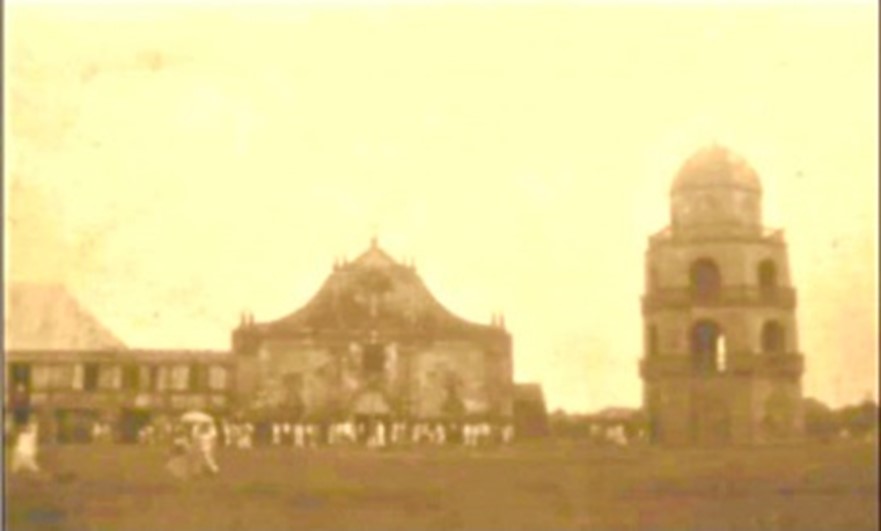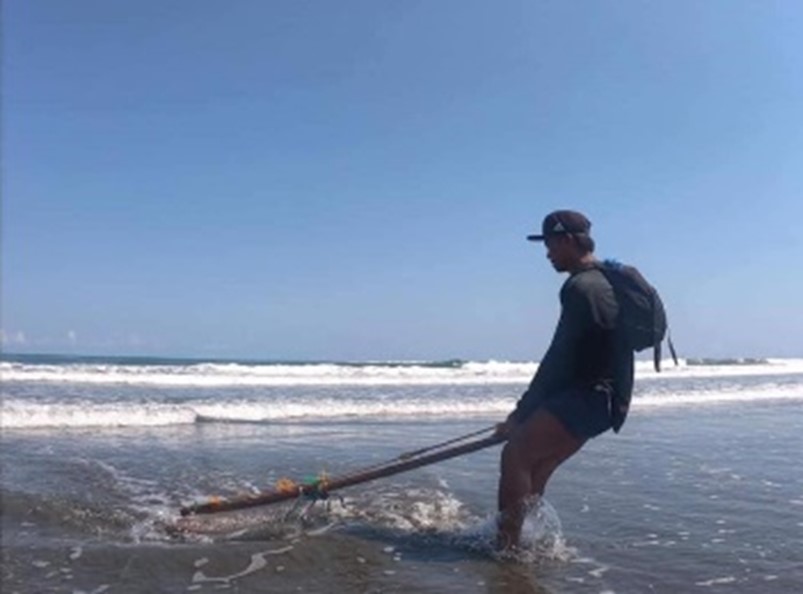By Mila Palattao
Every year, from May 1 to 12 Aparri celebrates its Town Fiesta. Each day of the Twelve days of festivities has different activities from Street Parade, School Presentations, Contests, Nightly Programs and Dancing. On May 11, Aparri honors its Patron Saint Peter Thelmo (San Pedro Gonzales of Thelmo) with a Fluvial Parade in remembrance of May 11, 1680 and May 11, 1682. Aparri is the only Town in the Philippines that celebrates its Town Fiesta for 12 days, a showcase of the fun loving and frivolous traits of the Ybanags. But all of these merry making has to be put on hold this year due to the Covid -19 Pandemic. To those planning to visit let us travel in time and rediscover Aparri, the Town “where the River meets the Sea”.
HISTORY

Aparri is a 1st class municipality in the province of Cagayan Valley, Luzon, Philippines. The Town sits at the mouth of the Cagayan River (the longest river in the Philippines) and the Philippine Sea. The valley is one of the largest tobacco-producing sections in the Philippines and the Town has a considerable coastwise trade. Aparri was then a Japanese trading post established in Year 1405 because of its location at the northern tip of Luzon. During Spain’s colony, Aparri was established as one of the major ports of the Galleon Trade because it is located at the mouth of the mighty Cagayan River towards the flourishing city of then Nueva Segovia, now Lallo. The Cagayan River where Aparri is in was the site of the famed 1582 Cagayan battles, the only major skirmish between Spanish Tercios and Japanese Ronin (Masterless Samurai). The original inhabitants of this town were the Ybanags/Ybanags. Later, as the Spaniards settled and with its strategic location, Ilocanos and Chinese people settled in the area.

It is believed that Aparri got its name when the civil and religious authorities in Nueva Segovia (now Lallo) decided in 1604 to erect a church there for the evangelization of the natives. The many priests who celebrated the first mass there remained to supervise the construction of the church and continued their evangelization work; subsequently, the natives referred to their place as “Aparrian,” an Ybanag word meaning “where priests resided.” On May 11, 1680, Aparri was officially inaugurated and was granted ecclesiastical recognition having for patron saint, Peter Thelmo.
Noting the fast growth of “Aparrian” in population and its strategic location for a sea port, the Spanish Authorities in Nueva Segovia again decided on May 11, 1682 to separate the delta from Camalaniugan and Buguey and granted it ecclesiastical recognition and at the same time to elevate the community to the status of a “pueblo” or a township, hence, the word “aparte de Camalaniugan y Buguey.” It was not long afterward that the word “aparte” evolved into “APARRI” by the natives.
Before the coming of the settlers from the Ilocos Region, Aparri has already a Port and Galleons were coming from Acapulco, Mexico. Mexican goods were unloaded in Aparri in exchange for native commodities like lumber, tobacco, dried/fresh fish, rice, corn and many others.

The ornate church of Aparri considered to be the best in Cagayan, was destroyed by an earthquake. It was rebuilt but during World War II, the Town proper of Aparri, including the Church, was devastated by bombing done by the liberating Americans who wanted to rid the Town of any Japanese occupiers. Donald Blackburn’s guerrilla forces and the local troops of the Philippine Commonwealth Army and Philippine Constabulary supported the Sixth United States Army Force B, in the capture of Aparri on 20 June 1945. After the war, Aparri was slowly rebuilt.
APARRI, TODAY

According to the 2015 census, Aparri has a population of about 66,000 people with an approximate income of Php 172 Million. Aparri is comprised of 42 barangays (villages) distributed on its 26,460-hectare area and located between the temperamental Cagayan River on the West, the Apagonan Creek on the South and the Babuyan Channel on the North. Aparri incorporates the Fuga Island of the Babuyan Group of Islands. It has a meteorological station, the Pagasa-DOST. The Town has a long sandy beach combed by racing waves.
Aparri’s Local Government, LGU, headed by Mayor Bryan Chan, has progressive administration focusing on the needs and safety of Aparrianos. The Administration’s proposed project to increase Police outposts and Medical Clinics on both Aparri East and Aparri West, provide added security & health services to all. Construction of roadways to Barrios provide needed safe access and transport of goods. Local products are encouraged to be developed with the hope for mass production and exports. Lately, even with this Pandemic, business continue to grow such Restaurants and Commercial Malls.

Aparri has added many schools through the years in all levels of Education-Primary, Secondary and Tertiary levels. The Aparri Kete School, St. Paul (formerly SHOMI), the Cagayan Valley Institute (CVI) and The Aparri School of Arts and Trades (ASAT) a Techno-Vocational High School under DepEd, has increased enrollment. Adjacent to ASAT Campus is The Aparri Polytechnic Institute under TESDA. The addition of Cagayan State University, Aparri Campus and the Lyceum of Aparri as a University offer undergraduate and graduate programs. With the growth of schools in Aparri, one need not leave Town to complete an education up to a Doctorate Degree. This growth of schools strengthened the close ties of family in the community and attracts people to Aparri.
For Sports enthusiasts, the Townspeople are active in Tennis, Biking, Group Zumba in the Park and Beach Surfing. The Public Park is currently under renovation to create different areas for sports and for people of all ages to enjoy the park. Aparri shores are kept clean thru the efforts of BKDK Organization.

Proposed plans of Cagayan Governor Manuel Mamba to revive Aparri as a Seaport has energized Business Owners and Developers in Town. In preparation for the Port Project, work has started in dredging the Cagayan River to protect river banks for erosion and floods safeguarding adjacent municipalities and farm lands. Projects to build 5 more bridges in the Province of Cagayan is active and include another bridge for Aparri that is being constructed-the Catotoran-Mabanguc Suspension Bridge, also known as Camalaniugan-Aparri Bridge, with a tentative completion by Year 2025. This bridge across the Cagayan River will be closer to Aparri than the Magapit Bridge. A nearby Lallo International Airport provides travel to nearby Asian Countries.

FOOD DELICACIES
If Davao or Cebu have the “danggits”, Aparri has variety of dried goods such as “Daing na Pusit“- ranges from small to the large ones, “Dadali”-when cooked deep fried, it taste like chicharon, “Dilis”, espadas “masingo“, and “Aramang”. During the month of October thru January, small fish called “Ipon” are available. Aparri is also noted for its “Gacca”, a small sea clam that abundantly grow along the Aparri shores.
At Fuga Island, try their native delicacy, the Coco crab.
If you visit Aparri between October & November, try the most expensive fish ever– “Ludong” (a variety of Pacific Salmon) also called “Presidents Fish”, that cost about Php4,000.00 to Php6,000.00 per kilo. Fresh catch of the day is available from fishermen as they dock at the Apagonan Creek adjacent to Aparri Market.
TRAVELING TO APARRI & VICINITY
Aparri can be reached by land transport (10 hrs. by car and 13 hrs. by Public Bus) from Manila, via the North Luzon Expressway or via the Ilocos Region and the Patapat Viaduct. Air travel is available from Manila to Tuguegarao City (the Capital of the Province) in about 45 minutes by either Philippine Air Lines or Cebu Air and then by land transport to Aparri about 55 miles.

But the best thing about visiting the northern tip of the country is that you will be able to see the scenic view of the mouth of the Cagayan River along the National Road. And if you travel via Ilocos Region you drive at the northern edge of the Cordillera Mountain Ranges along the Philippine Sea shore thru the Patapat Viaduct pegged as “Just at the edge of Heaven” and crossing the Cagayan River by way of the Magapit Suspension Bridge connecting the East and West Baranggays of Aparri.
A more direct way to visit the West Baranggay is taking a wood boat “Banka” ferry with a “Kuliglig”motor traversing the Aparri East to Aparri West and Vice-Versa across the Cagayan River.

You can also visit Fuga island, much better than Boracay for me, for it’s really a pristine Island with white sand and calm blue waters. Fuga Island, privately owned by Fuga Island Holdings and under the Administration of Aparri, is a two-hour Ferry ride from Claveria.
When domestic and international travel opens, for those who had not visited Aparri for quite sometime, let’s journey back to our hometown of Aparri.
REFERENCES:
- Wikipedia
- Internet Articles
- Aparri Local Government
- Provincial Social Media
- Department of Education


